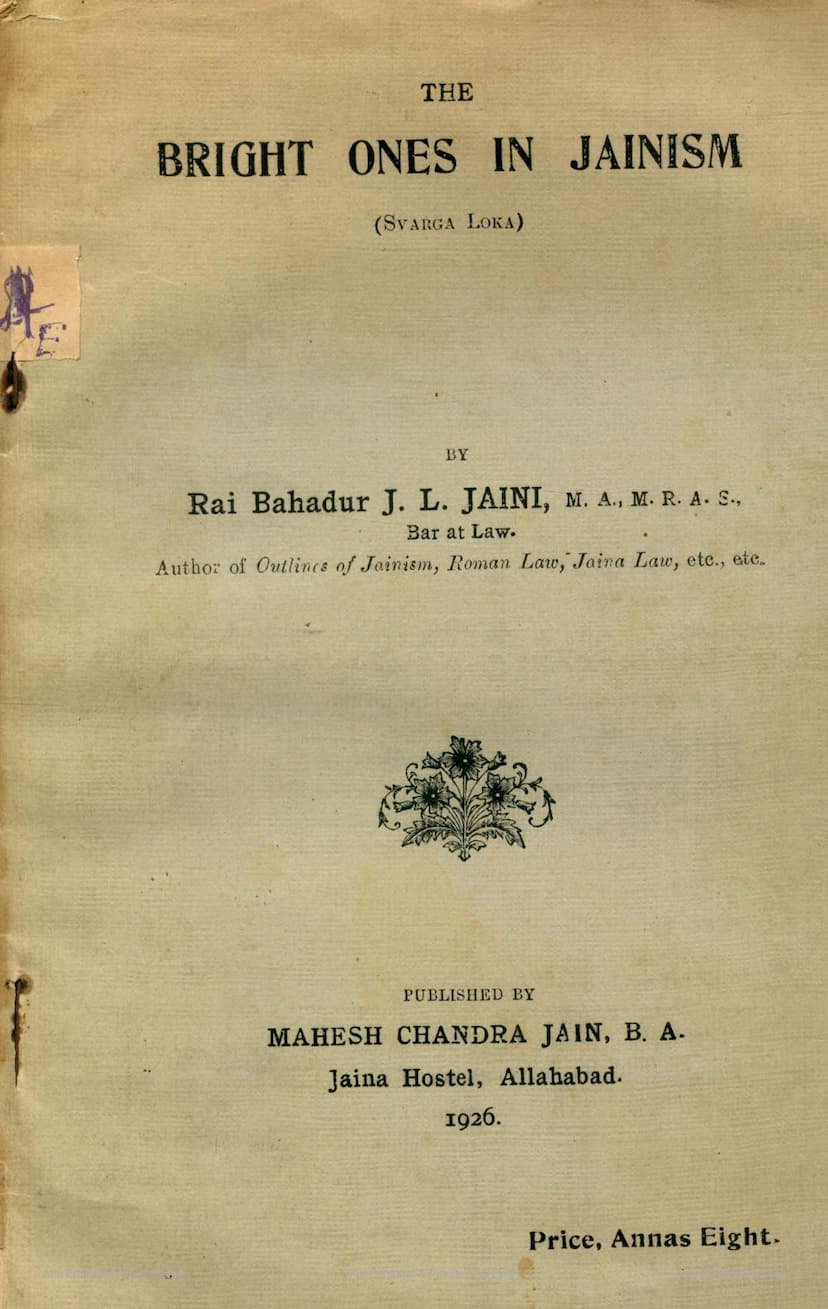Bright Ones In Jainism
Added to library: September 1, 2025

Summary
This document is a summary of the Jain text "The Bright Ones in Jainism" by Rai Bahadur J. L. Jaini, published in 1926. The book provides a detailed account of the celestial beings (Devas) in Jainism, distinguishing them from the ultimate liberated souls (Siddhas).
Here's a breakdown of the key points covered:
-
Definition of "Gods": In Jainism, the highest ideal being is the "Siddha" (liberated soul). The term "God" in this context refers to "Devas," which are mundane, embodied souls residing in celestial realms. They are called "bright ones" due to their luminous constitutions and inherent eight heavenly acquisitions (powers like shrinking, expanding, changing form, etc.).
-
Bodies of Devas: Devas possess fluid or changeable (Vaikriyaka) bodies, distinct from the Karmic, Taijasa (luminous), and Audarika (physical) bodies common to all embodied souls. This Vaikriyaka body allows them to change their form at will, a concept found in various mythological and literary traditions.
-
Orders and Classes of Devas: Devas are categorized into four main orders:
- Residential (Bhavanavasi): 10 classes, including Asurakumara, Nagakumara, etc. They reside in the lower celestial regions.
- Peripatetic (Vyantara): 8 classes, such as Kinnara, Yaksha, etc. They are often described as moving about.
- Stellar (Jyotisha): 5 classes, representing celestial bodies like the Sun, Moon, planets, and stars.
- Heavenly (Vaimanika): 12 classes, further divided into Kalpopanna (those born in 16 heavens) and Kalpatita (those born beyond).
-
Grades within Orders: Most celestial orders have a hierarchical structure with grades like Indra (king-like), Samanika (ministers/teachers), Trayastrinsa (33), Parisad (courtiers), etc. However, Peripatetics and Stellar beings have a slightly different structure.
-
Numbers and Residence: The text provides intricate calculations and descriptions of where these different classes of Devas reside, from the lower strata of the earth's upper world (Ratna Prabha) to progressively higher celestial heavens. The Stellar beings occupy specific orbital paths around Mount Meru and beyond.
-
The 63 Celestial Strata (Patala): The upper world is described as having 63 layers, each containing central abodes for Indras and numerous other celestial abodes. The distribution of these strata is linked to the different celestial orders and heavens.
-
Indras: Each order has its own Indras, with the total number of Indras in the Jain pantheon reaching 100. Each Indra has a Prati-Indra (heir-apparent), except for the Indras of humans and sub-humans.
-
Living and Enjoyment: Devas are born spontaneously, without physical birth processes. They possess sex and have families with goddesses. Their forms are luminous and ethereal. The text details varying levels of sensual enjoyment (bodily union, touch, sight, mind) based on the heaven they inhabit, with higher beings having less or no sexual impulse.
- Laukantikas: A special group of Deva Rishis (celestial sages) in the 5th heaven who are in their last celestial incarnation and will attain liberation as humans.
-
Who are Born as Gods?: The text outlines the karmic causes for rebirth as a celestial being, including self-control with attachment, control of vows, equanimous submission to karma, austerities, and right belief. Specific types of good deeds and conduct lead to birth in particular celestial orders and grades.
-
Colours, Age, and Stature: The Devas' colors, lifespans (measured in Palya and Sagara), and stature are detailed for each order and heaven, generally showing a decrease in size and an increase in lifespan as one ascends to higher realms.
-
Food Interval and Respiration: Devas do not consume ordinary food but experience hunger at fixed intervals. Similarly, they respire at set intervals. The text compares these intervals to human experience, suggesting a much slower biological process.
-
Comparison and Conclusion: The Jaina description of Devas is presented as complex and detailed, often linked to an allegorical representation of the human form. The author concludes that these descriptions are meant to be literally true within Jain cosmology.
The book serves as a comprehensive guide to understanding the nature, hierarchy, abodes, and characteristics of celestial beings within the Jain philosophical framework, aiming to clarify common misconceptions about Jain deities.